Joy Denise Scott had two strong desires pulling her in seemingly opposite directions: making and thinking. She enjoyed sewing and stitching, and at one point, she started her own lingerie business. But she also felt a strong pull toward academia and a thinking life.
At first, Joy believed creative skills were inferior to intellectual skills. But when writing a social science doctorate thesis at Curtin University (Australia), Joy began to imagine how her two passions could coexist. During her daily writing practice, Joy reflected on how wordcraft and stitch are both concerned with the ritual performance of ‘doing’, as well as making meaning. And that led to exploring new ways to communicate her feelings combining poetry and stitch.
Having sewn and lived across four continents (England, Australia, United Arab Emirates, and China), Joy’s textile art has something to say about identity, culture, gender issues and ageism. And she’s found the confidence to now share her work, thanks in part to the support of her TextileArtist.org Stitch Club peers.
Poetic inspiration
Sewing into the void
Into the breath
a meditation ritual
the silk dressed needle
rises and falls
gliding in and out
of the linen flesh…
I had used the metaphor of stitch when writing my doctorate thesis, so in early 2019, it seemed a natural progression to move from metaphor to actual stitchwork. I have stitched all my life, but I hadn’t been using it to translate my thoughts and ideas. I wasn’t sure how to start, so I turned to my textile artist friend and educator Anne Farren, who gave me the push I needed. Since then, poetry has been the trigger for my stitch work.
My passion to stitch to fill the between times of daily existence has become an enduring one. I would describe this inner persona as my stitching self. And rather than just writing memoir in the form of poetry, I am crafting my life stories with thread and cloth.
Both my poetry and stitch work have strong autobiographical elements. I reflect on feeling as a way of exploring the question ‘where am I in the scheme of things?’ My poems focus on grief, loss, alienation, difference and gender issues relating to age and expectations of ourselves and relational others. Both the writing and stitching have helped me heal and work through a lot of emotional trauma and angst concerning particular moments in my life.
There are times when I work directly from a poem, and there are other times whilst stitching I am reminded of a poem or a few lines of it. There have also been times when a whole new poem emerges from the work itself.


Loss of a dear friend
One of my favourite works is Stitching sorrow into flesh. It’s a portrait of my Chinese friend and colleague Chen Zeng Hao who died suddenly whilst I was living and working in Shanghai.
My doctorate and much of my poetry was inspired by the five years I knew Chen and my resultant grief of losing someone special within an alien culture. My not knowing the Chinese language and cultural signifiers made it difficult to process his loss, and they didn’t understand mine in return. There was a double edge to my grief in that I was caught up in a cycle of trying to reconcile something I didn’t quite know how to work through.
To that end, the portrait is double sided to represent both sides of grief and loss. China has a strong tradition of double-sided embroidery that is also known as two-faced embroidery. Mine differs in that I leave the threads loose on the reverse side, so there is a sense of something not settled or resolved.
The front depicts the humility and harmonious nature of Chen and frames him as a contemporary man enjoying the simple pleasure of drinking tea in the local tea house. The reverse side depicts my sorrow and the deep traditional Chinese roots that are hidden from view but very much present.
Although it’s more planned and representational than my later work, the process of designing and making helped me realise my interests lay in capturing the essence of feeling more than true representation.


I also created a small collection of poems in response to Chen’s passing in which I ruminate on my grief and sense of cultural disorientation. Those poems inspired my Grief Series and raise questions about how one expresses her authentic self when the rules of the game are unknowable. How can we really know another person? And where does my grief lie?
A foreigner’s grief
A gathering of yellow and white emperors
lean into the blackest of walls
Majestic heads slump
reduced by their solemn cargo
Once proud they
weep petals of words
A noble spillage
of
Feeling
Relationship
Commiseration
Making a bed of love
and
Love unspoken…
For the Grief Series: Wall of Grief, I had a strong visual concept from the beginning, as the poem to which the work refers provided a set of visual cues. But after creating a detailed layout, it took many stitch samples across two years before I was happy with the result.
From the start, I understood the backing cloth should be neutral and the stitch forms and colour palette restricted to grey tones with two shades of yellow for the flowers and petals. Seed stitches and French knots would be used to create texture, and a back stem stitch to outline the work.
My challenge was how to balance the subject matter’s different elements, so each stood separately in its own right but collectively conveyed my feelings of alienation and internalised struggle as a non-Chinese woman.
Indian painter Raqib Shaw’s online exhibition A Summer Among the Narcissi gave me the idea to float the segmented subject matter in negative space. I did this not only to convey a mood of peace and sorrow but to also suggest how Chinese floating space is used in traditional landscape paintings. I also happened to be taking a workshop with Sue Stone in TextileArtist.org’s Stitch Club that was timely. Sue helped me to isolate the background from the subject matter and consider its importance in its own right. She also taught me how a background can convey a particular emotion and ambience, which helped me design a more detailed layout featuring the value and use of negative space in the composition.



Reflections upon ageing
My Relic Series was inspired by a TextileArtist.org Stitch Club workshop with Jennifer Collier. Members were challenged to create a stitched 2D paper glove. I modified the challenge by drafting a full glove pattern using my hand as the model. During that process, I reflected on the fact I no longer had young, subtle skin, and my finger joints were showing signs of arthritis.
This made me think about the significance of ageing on the female body for both me and society. I was tapping into long-held anxieties about ageing that became exacerbated by Covid fears. So, once I finished the challenge, I felt compelled to further develop my thoughts on ageing and a sexagenarian body.
The act of stitching in its various expressions has evolved as an essential part of my identity. It’s not just a form of meditation or my central art form, it’s also an orientation practice that creates a sense of place wherever I find myself, emotionally and geographically.
The starting framework for both Relic Series: Feeling my way into meaning and Relic Series: What lies beneath my breast is mulberry bark. I dyed the bark with onion skins to represent ageing flesh, and then I worked embroidery and appliqué directly into the bark. Weaving stitches were then applied to express emotional repair, along with seed stitch to articulate the life force and wrapping stitches to represent everyday messy entanglements.
Feeling my way into meaning features a portrait of my hand. It’s a comment on the sexagenarian female body saying although contemporary society places emphasis on surface beauty and intelligence, there is beauty and meaning to be found in an ageing body’s markings.
And What lies beneath my skin is a portrait of my ageing breasts and is grounded in the notion of how feelings are intimately tied with how we experience the world. In this piece, I reflected upon cultural and social ways of thinking, the constraining nature of patriarchy and how these matters permeate the intricacies of my everyday experiences as a sexagenarian woman.
…threads and stitches of the flesh
arranged to unbalance the smooth tongue of fiction
uncovering the complexities of the real…



Trusting the creative process
I begin a work not so much focused on a particular story or memory but rather a sense of tapping into the unknown to uncover something I don’t yet understand.
Sometimes I just grab a couple of scraps of fabric and go from there. I let my hand and feelings guide me rather than beginning with a plan. This requires complete trust in the process, something I have gained through TextileArtist.org’s Stitch Club community where many makers place their confidence in the process of making.
It’s very much like writing. I put a few stitches there on the cloth, and they take flight. Seed stitches take on a kind of breath, flowing and changing direction and texture. I pause to change colour or thread or both, then maybe a French knot beckons or a bullion or chain stitch.
It takes nerve to trust the process. Often nothing appears to be going right, and then from nowhere, stitches start to fall into place, and the work takes on a life of its own. I call it waiting for the breath to happen.
Sometimes my work must sit for a while before I can fully appreciate the deeper connections between pieces. It would be more accurate to say I don’t necessarily have an intention to create a series, rather it inflicts itself upon me. There are times when I’m working on a piece when a realisation slowly creeps up that I am digging into something psychologically significant and deep. My Relic Series certainly came out of that headspace.
For a couple of years, I’ve been working on Real bodies have their lives stitched into them: Burial frock. For months at a time, I didn’t know if what I was doing was working, but the frock kept pulling me back in. I’m about to exhibit the frock as a work in progress, as I feel it is now speaking to me and can stand up to the public’s gaze and critical scrutiny.


Finding my tribe
I joined Stitch Club in 2020. At the time, I didn’t belong to any textile groups, and I didn’t use Facebook or other social media. Stitch Club provided a gateway into a circle of like-minded people, and I also liked how it was an international space. I discovered my tribe, which gave me the confidence to join local textile organisations, including the Western Australian Fibre and Textile Association (WAFTA) and British textile artist Jayne Emerson’s online group called The No Rules Society.
Early on, I was so concerned with having a finished product. I would undertake sampling, but it was always with a clear indication of where I was going. But after taking workshops in Stitch Club, I’m now much more intuitive and improvisational with sampling, allowing cloth, thread and stitch to take the lead.
This notion of stitching into the mystery of something, not knowing where I am going, has been liberating. Stitch Club has enabled me to break out of a self-imposed cycle of self-criticism which I call the ‘wild monkey on my back’.



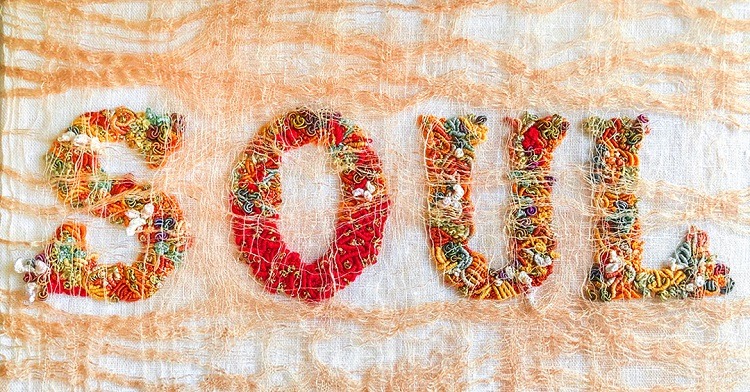
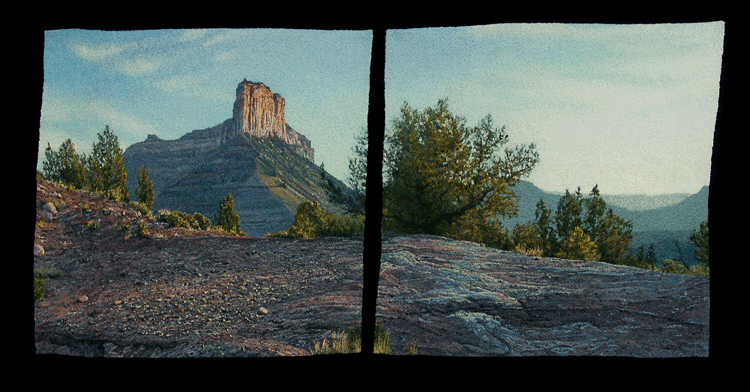
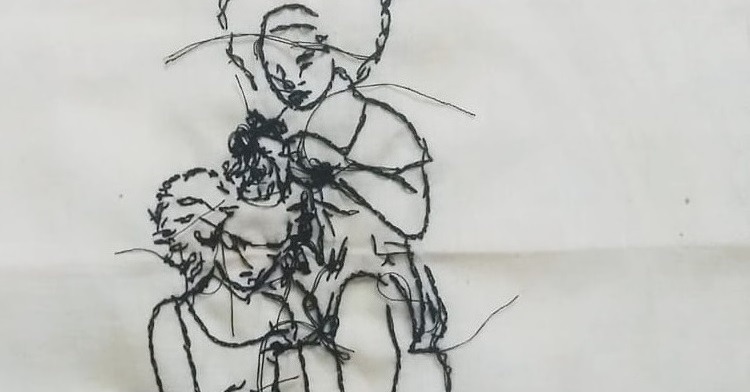
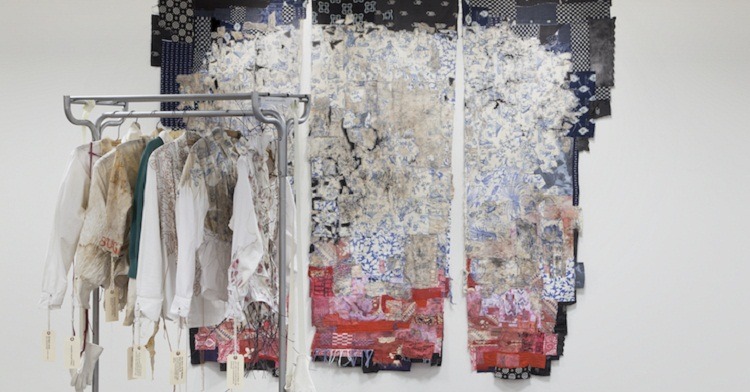
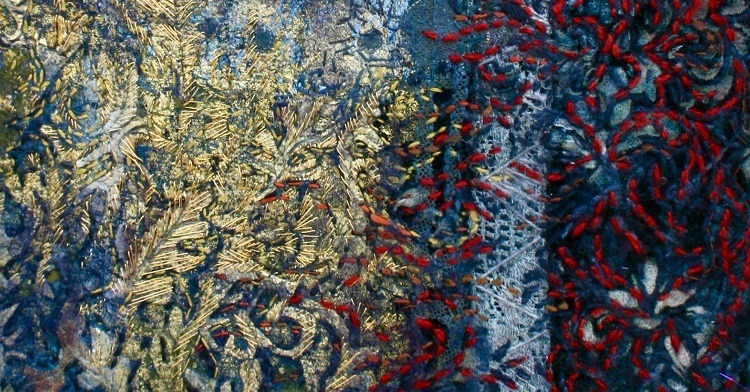
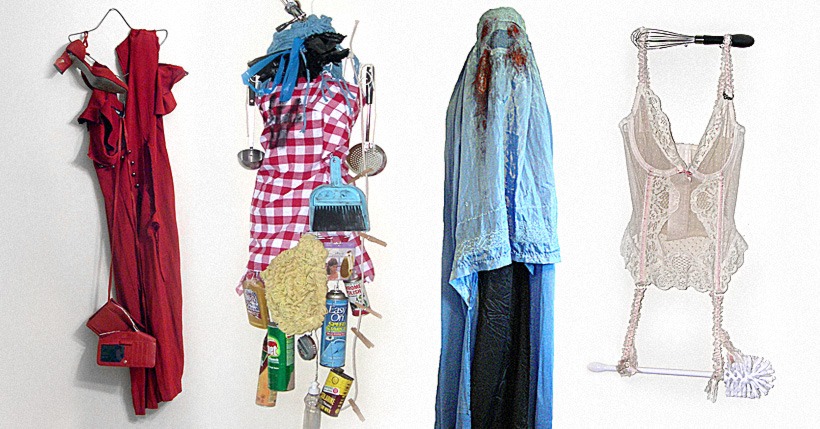
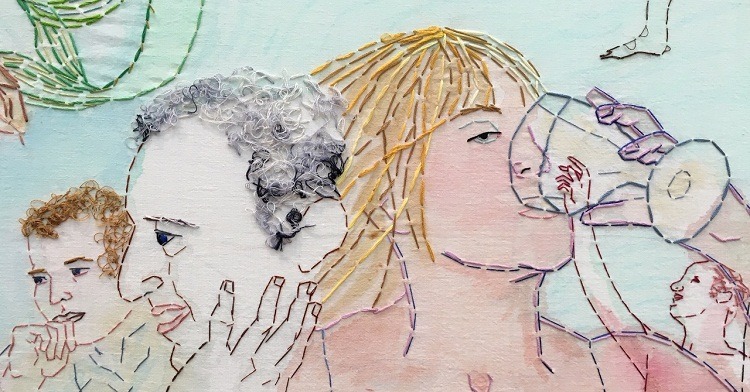
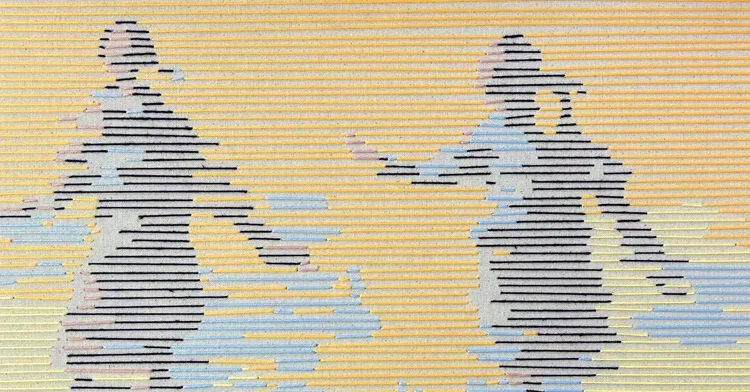
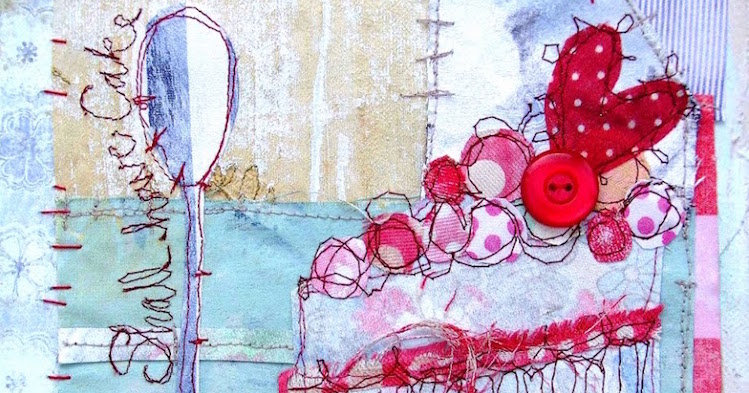
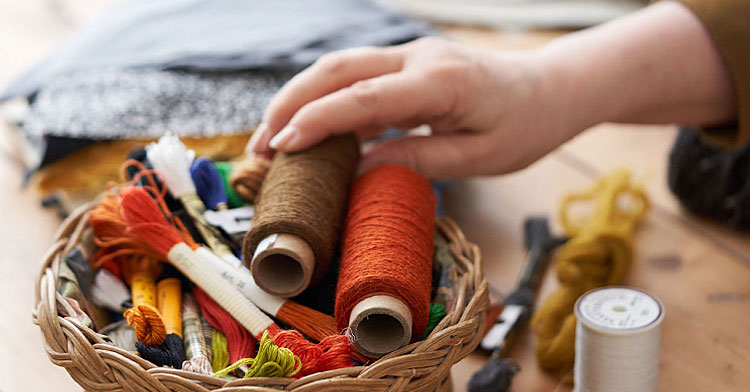
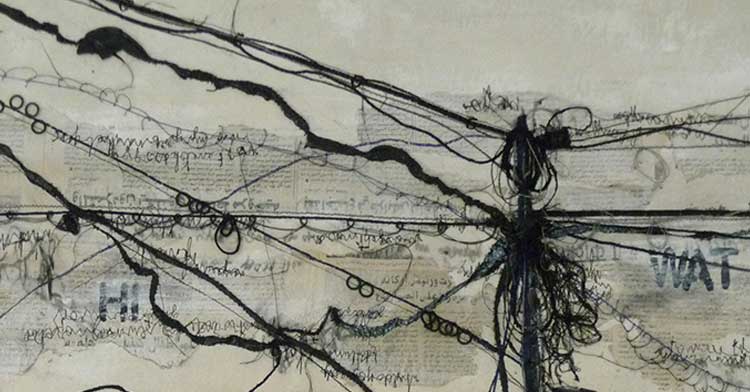
16 comments
Linda Florio
Hi Joy, sorry I missed this post. The work is wonderful as are your ideas. Keep us all posted in the SC. You have been able to forge ahead into a professional arena. Good luck!, Linda
Joy Denise Scott
Thankyou Linda.
Julie Mcgurk
Thank you so much for sharing your journey, I have read, been thoroughly moved and encouraged by it. I am at the beginning of my intuitive stitching journey and I also write personal poetry to work through life experiences both difficult and celebratory. I love your work, it is very beautiful.
Joy Denise Scott
Thankyou so much Julie for your generous words. I feel that poetry enabled me to anchor myself into the work at the beginning of my stitch journey – as in gave me something to hold onto but at the same time allowed me to let go and let the stitch muse do her work. Its a very exciting time – I would be very interested to hear how you go in the coming months. Happy New Year – Joy
Joy Denise Scott
Thankyou Roshni
I am so pleased that my worked has touched you in this way. Best wishes Joy
Roshni
Your art hit a goal on the soul. You’re a great artist. I always think about how to do these works and what it takes to do it.
Joy Denise Scott
Hi Kit
I went and had a look at Maria Lai’s work – you were correct very inspirational. Some of her words I came across were: “It doesn’t matter if you don’t understand, just follow the rhythm.” I totally get that and could not have expressed the sentiment any better. Thankyou so much for your generous words and wishing us both many more years of happy stitching in whatever form the muse chooses to move us. All the best – Joy
kit sutherland
Thank you so much, Joy. I took notes and drew as I read your inspiring story. I love the two-faced embroidery and the notion of something not settled or resolved: there is rarely a final word. Do you know (also) the sewn book works of Sardinian artist, Maria Lai – sadly missed. She too used hanging threads, perhaps to express the private, the secret, the elusive, the mystery of it all. I am a septuagenarian. There’s lots of energy still there! I wish you continuing fulfilment!
Kate Reese
I’m struck.by how you utilized a world wide pandemic to come to terms with and within yourself. It’s quite beautiful and perhaps admirable at the same time. You are also inspiring just by telling us your story.
Joy Denise Scott
Hi Kate
Sometimes we are forced into sitting with ourselves, regardless of whether we like it or not. It took me a while to realise that I had something to say. Thank you for your feedback it will help to keep pushing me on.
Holly Coburn
Sharing your grief with us in such a beautiful and poetic way is generous, inspiring, and deeply moving. Thank you.
Joy Denise Scott
Hello Holly
Your feedback is so much appreciated and gives me the confidence to continue forward in the knowledge that my work is being understood. Thank you
Alison Harker
I love all your sentiments and how you have allowed the process to lead you along your own expressive journey, not worrying about the arrival.
Thank you for sharing your thoughts and long may they continue to give you pleasure along the way!
Joy Denise Scott
Thank you for your generous comments Alison I am so touched that you get what I am attempting to say and do. May you enjoy your own stitch journey and wherever it takes you.
Astri Raestad
So beautiful works. Warmed my heart in the cold west coast of Norway this morning.
Joy Denise Scott
That is such a lovely thing to say Astri. I have never been to Norway so I can only imagine how cold your winters must get. It’s a beautiful summer late afternoon here in Perth.